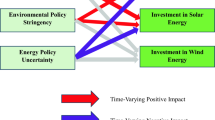Abstract
With the 2015 Paris Climate Accords, 196 nations agreed to limit carbon emissions. When, in 2017, then-President Trump announced that the USA would withdraw from the agreement, new/substitute support for carbon-emissions reduction came from individual state initiatives. The Regional Greenhouse Gas Initiative (RGGI) is the most significant of these endeavors. Ten northeastern states agreed to limit carbon emissions from power plants beginning in 2009. In the study reported on here, power plants included in RGGI are matched against similar American power plants that are unregulated with respect to carbon emissions. The objective is to determine how effective the regulation is in reducing emissions. From a public policy perspective, comparing regulatory programs to voluntary abatement attempts will help determine the appropriate route to take for achieving a reduction of GHG emissions. Our findings indicate that RGGI plants significantly reduced their carbon emissions over the study period (2011 to 2015) compared to a matched set of control plants that are not regulated. Of potentially greater importance, carbon emission efficiency of the RGGI plants significantly improved over the period from 2008 (pre-RGGI period) to 2015 (RGGI period), while the matched control plants did not achieve this outcome. The overall results imply that a mandatory regime, such as RGGI, is more effective than are voluntary initiatives in driving electric utility plant owners to take actions regarding their production process that can lead to curtailment of carbon emissions.


Similar content being viewed by others
Notes
The source data were prepared by the Bureau of Economic Analysis in the US Department of Commerce and are available at: https://www.bea.gov/data/economic-accounts/regional.
The source data were compiled by the US Energy Information Administration and are available at: https://www.eia.gov/totalenergy/data/browser.
The source data are available at: https://www.ncei.noaa.gov/access/metadata/landing-page/bin/iso?id=gov.noaa.ncdc:C00532.
The source data were obtained from the “State climate policy map” in the website of the Center for Climate and Energy Solutions: https://www.c2es.org/content/state-climate-policy/.
References
Bel, G., & Stephan, J. (2015). Emission abatement: Untangling the impacts of the EU ETS and the economic crisis. Energy Economics, 49, 531–539.
California EPA, Air Resources Board (2016). The Governor’s climate change pillars: 2030 greenhouse gas reduction goals. http://www.CA.gov/ccpillars/pillars.htm.
Davenport, C. (2014). Nations approve landmark climate change accord in Paris. New York Times (December 12).
Davenport, C. (2015). Obama to take action to slash coal pollution. New York Times. (June 6).
Freedman, M., & Stagliano, A. J. (2008). Accountability and emissions allowance trading: Lessons learned from the U.S. electric utility industry. Social and Environmental Accounting Journal, 28(2), 62–77.
Freedman, O., Freedman, M., & Stagliano, A. J. (2015). Assessing CO2 emissions reduction: Progress toward the Kyoto Protocol goals in the European Union. International Journal of Business and Social Research, 5(11), 75–86.
Freedman, O., Freedman, M., and Stagliano, A. J. (2018). Beyond Kyoto—Using a cap-and-trade mechanism to reduce carbon emissions: A policy perspective on the European experience. Midwest Economic Association Conference Proceedings.
Jiang, J., Xie, D., Ye, B., Shen, B., & Chen, Z. (2016). Research on China’s cap-and-trade carbon emission trading scheme: Overview and outlook. Applied Energy, 178(September 15), 902–17.
Lyon, T. (2003). Voluntary versus mandatory approaches to climate change mitigation. Resources for the Future. Issue Brief 3–0 (February).
Murray, B. C., Maniloff, P. T., & Murray, E. M. (2015). Why have greenhouse emissions in RGGI states declined? An econometric attribution to economic, energy market, and policy factors. Energy Economics, 51, 581–589.
RGGI (2013). Regional greenhouse gas initiative: An initiative of the northeast and mid-Atlantic states of the U.S. http://www.rggi.org.
US Environmental Protection Agency. (1990). The Clean Air Act amendments of 1990: Summary materials. U. S. Government Printing Office.
US Environmental Protection Agency. (2006). EPA acid rain program, clean air markets program. U. S. Government Printing Office.
US Federal Register (2009). Mandatory reporting of greenhouse gases, 74 (68): 16448–603.
Wang, S., Wan, L., Li, T., Luo, B., & Wang, C. (2018). Exploring the effect of cap-and-trade mechanism on firm’s production planning and emission reduction strategy. Journal of Cleaner Production, 172(January), 591–601.
Author information
Authors and Affiliations
Corresponding authors
Ethics declarations
Conflict of interest
The authors declare no competing interests.
Additional information
Publisher's note
Springer Nature remains neutral with regard to jurisdictional claims in published maps and institutional affiliations.
Rights and permissions
Springer Nature or its licensor (e.g. a society or other partner) holds exclusive rights to this article under a publishing agreement with the author(s) or other rightsholder(s); author self-archiving of the accepted manuscript version of this article is solely governed by the terms of such publishing agreement and applicable law.
About this article
Cite this article
Cong, Y., Freedman, M., Park, J.D. et al. Carbon emission regulation of electric utility generating plants: new evidence on differential outcomes from mandated versus voluntary CO2 reduction initiatives. Energy Efficiency 15, 71 (2022). https://doi.org/10.1007/s12053-022-10081-6
Received:
Accepted:
Published:
DOI: https://doi.org/10.1007/s12053-022-10081-6




